1lumen selects and reviews products personally. We may earn affiliate commissions through our links, which help support our testing.
Mateminco FW1 review
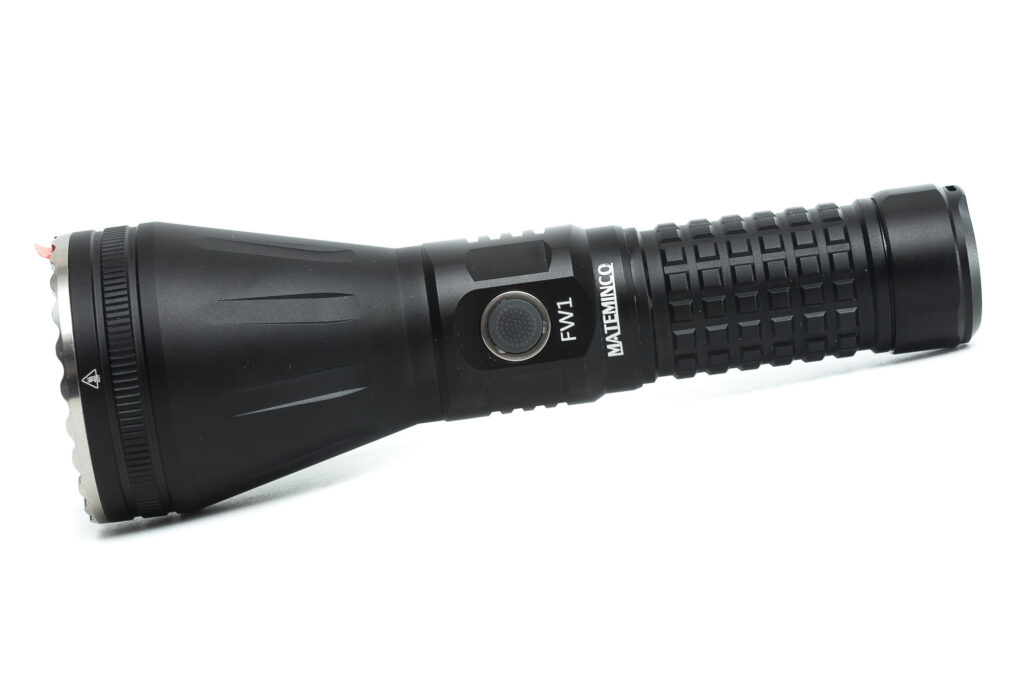
Mateminco FW1 specifications
| Brand/model | Mateminco FW1 |
|---|---|
| Flashlight category | LEP flashlight / Long-range / searchlight |
| LEP | Mirror-type LEP |
| Max. output | 562 Lumens |
| Max. beam distance | 2,952 meters |
| Max. beam intensity | 2,180,000 cd |
| Battery config. | 1*26650 / 21700 |
| Onboard charging | USB-C |
| Modes | 3 |
| Blinkies | Strobe |
| Waterproof | IPX6 |
| Review date | February 2024 |
Review intro:
We have reviewed many LEP flashlights so far, and we now got an updated Mateminco FW1!
LEP flashlights have gained immense popularity in the past few years. This popularity is due to their unique feature of using a laser instead of an LED as the light source. These flashlights use phosphor to transform the blue laser light into whitish/yellowish light. Although LEP flashlights emit light similar to LED flashlights, their beam divergence is much narrower, enabling them to shine farther. Furthermore, LEP flashlights have a lower total lumen output than most LED flashlights.
And today we are having a look at the Mateminco FW1
The Mateminco FW1 resembles the Astrolux WP3 we reviewed a few years ago. However, I’m pleased to inform you that the FW1 (and WP3?) have received an upgraded driver. How does it compare to the old driver? Let’s find out.
So, let’s find out if the new driver has helped.
Package quality.
The Mateminco packaging was pretty basic, with a brown carton box, and the following inside:
- The Mateminco FW1 flashlight
- 21700 battery adapter
- Lanyard
- Manual
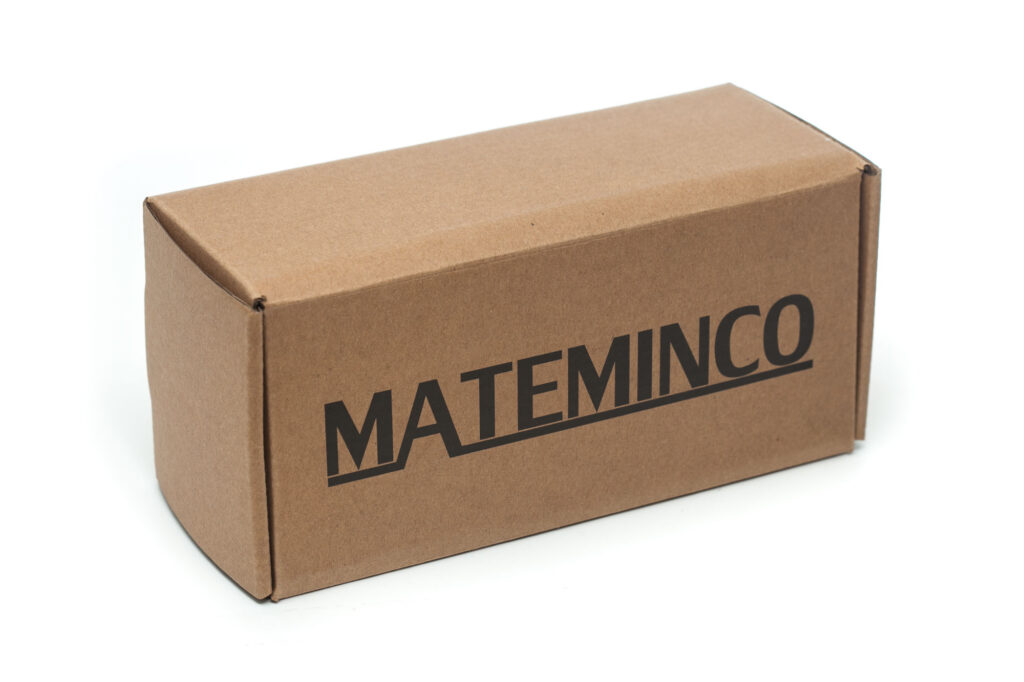
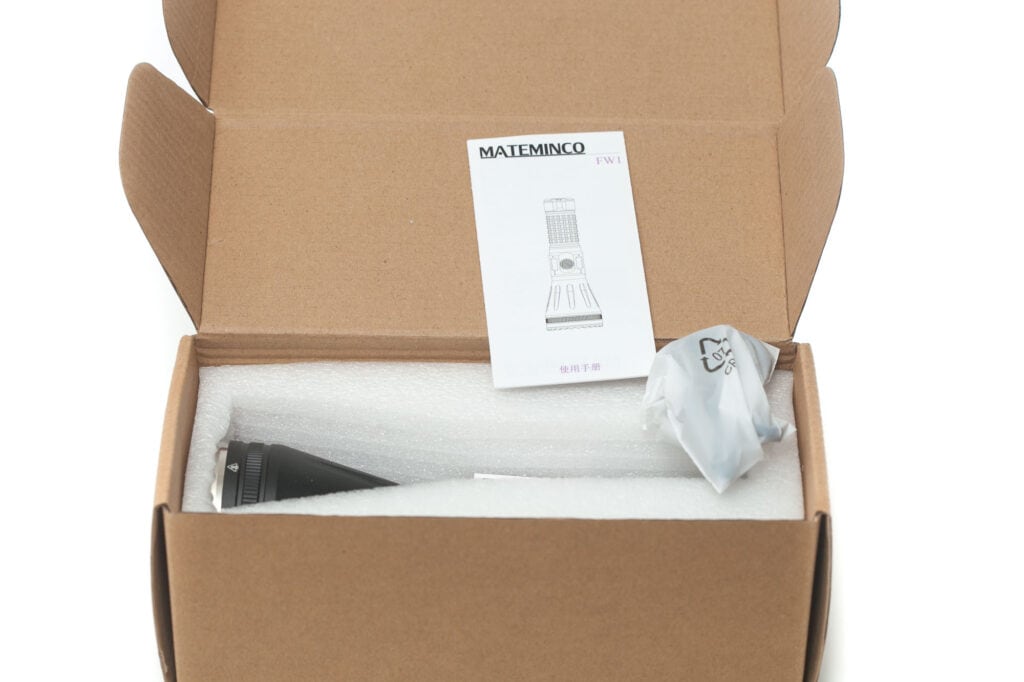

Flashlight in use, Build Quality, and Warranty
One of the first things you’ll notice is the large flashlight body diameter and a rather rough knurling. I love the way it feels and fits in my hands because of this.
There is only one electronic switch in the flashlight, and it is located in the neck. Although the position is relatively convenient, it would have been better if it were located a bit more forward so that the thumb could naturally rest near the switch. Nevertheless, it is easy to carry in the underhand position without requiring a switch in hand position.
You can also use it overhand to manipulate it when your middle finger is near the switch.
Mateminco included a lanyard, so if you don’t like carrying it in your pocket, there’s your second option.
The anodization is pretty good, with a matte finish. And there is no discoloring or anything else of that matter.
The flashlight’s body can be unscrewed from both ends, and it has bare threads towards the head and anodized threads towards the tailcap. Regarding the tailcap, Mateminco has used a double spring to reduce resistance for higher amps. I’m unsure how much of a difference it makes, but it’s a nice feature.
The tailcap screws down relatively easily because the threads are lubricated, as well as the o-ring. There is even a second slot to add an extra o-ring, so you can be more sure there’s no water entering through the tail cap.
I can see the FW1 being used for search and rescue but also as a beacon in the sky.
Warranty?
Mateminco does not have an official website, but they do have a Facebook page you can visit, and perhaps get some of your warranty claims solved. https://www.facebook.com/Mateminco
And they also have an official store at Aliexpress: https://mateminco.aliexpress.com/store/4196004
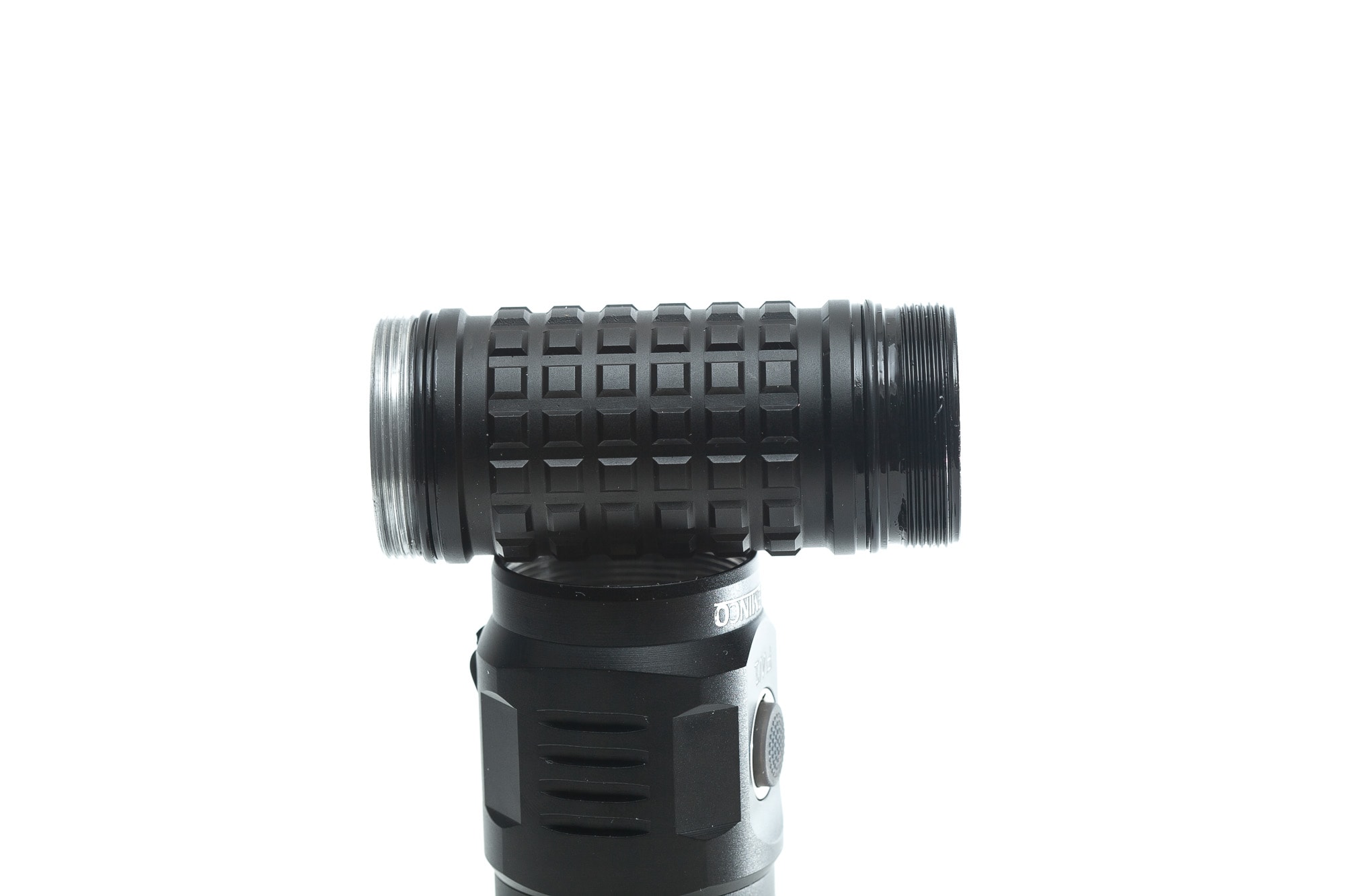
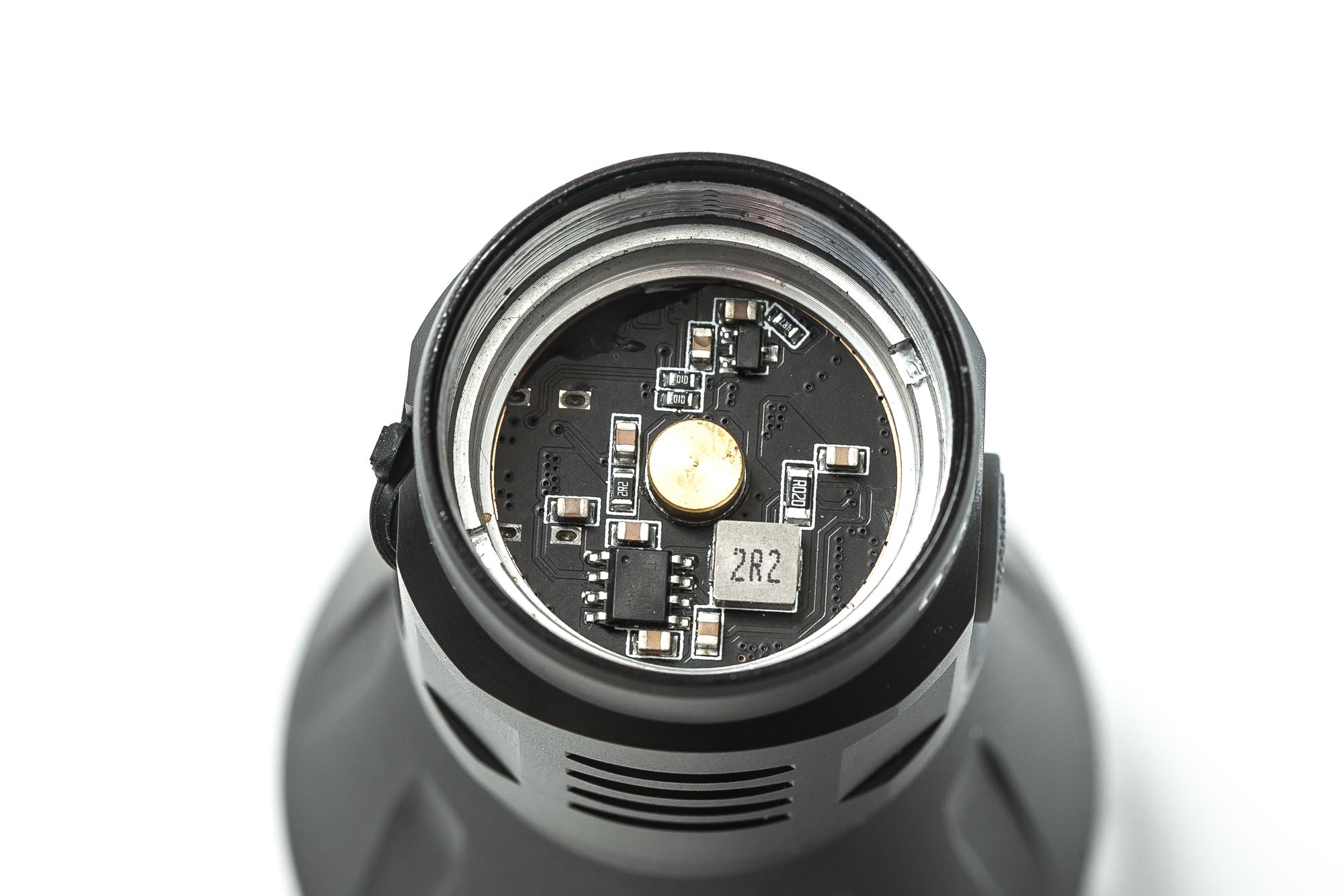
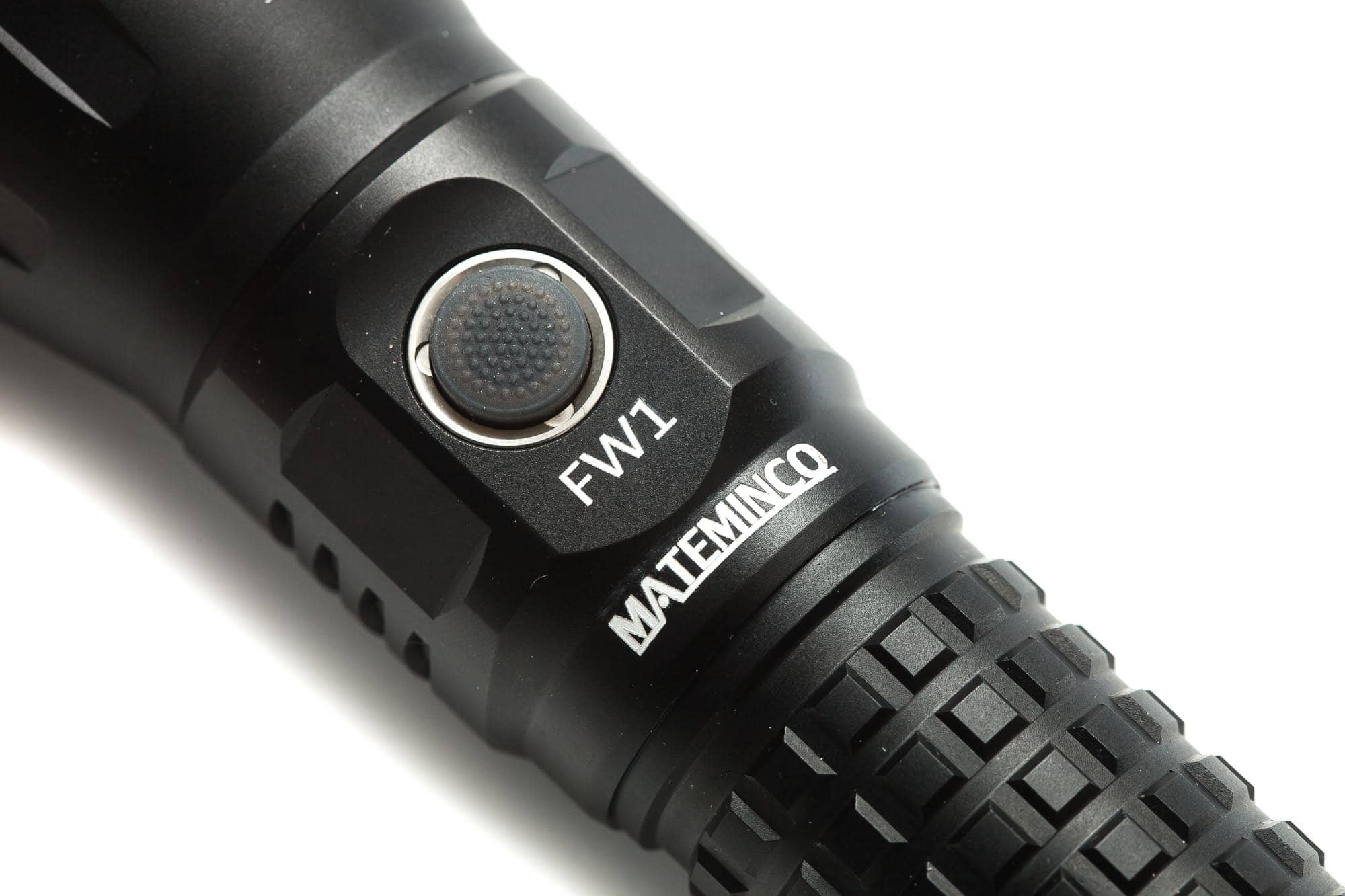
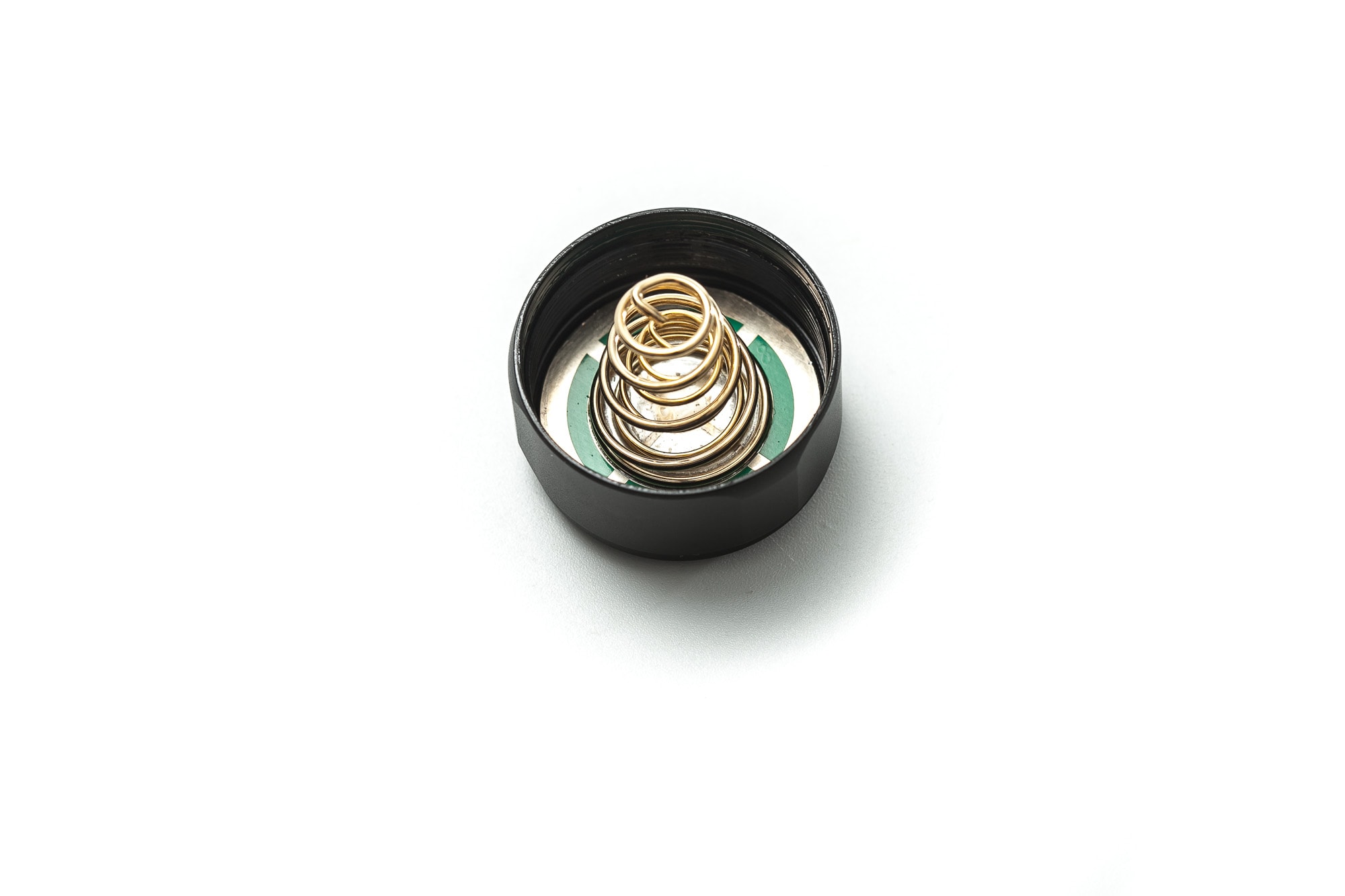
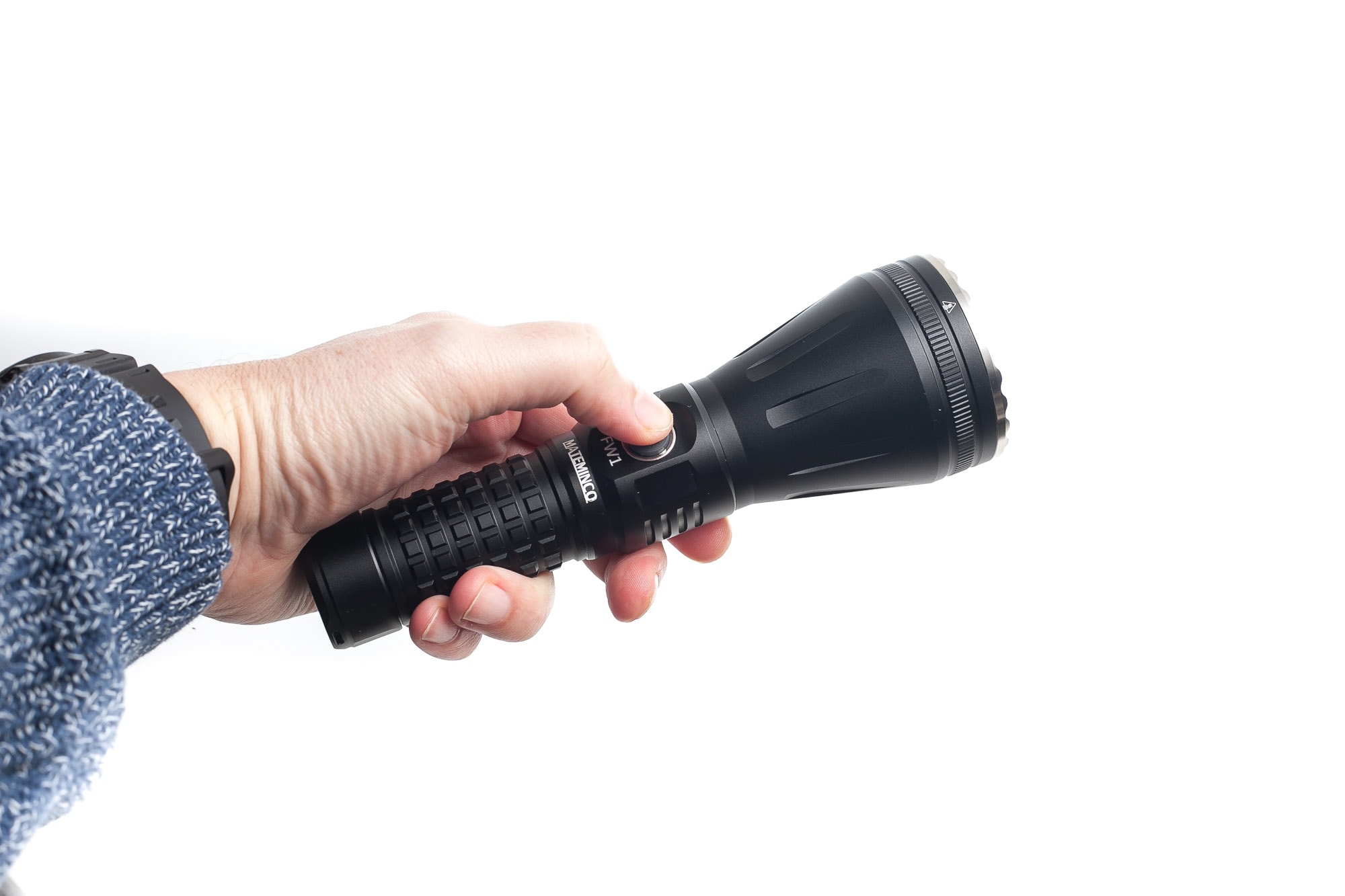
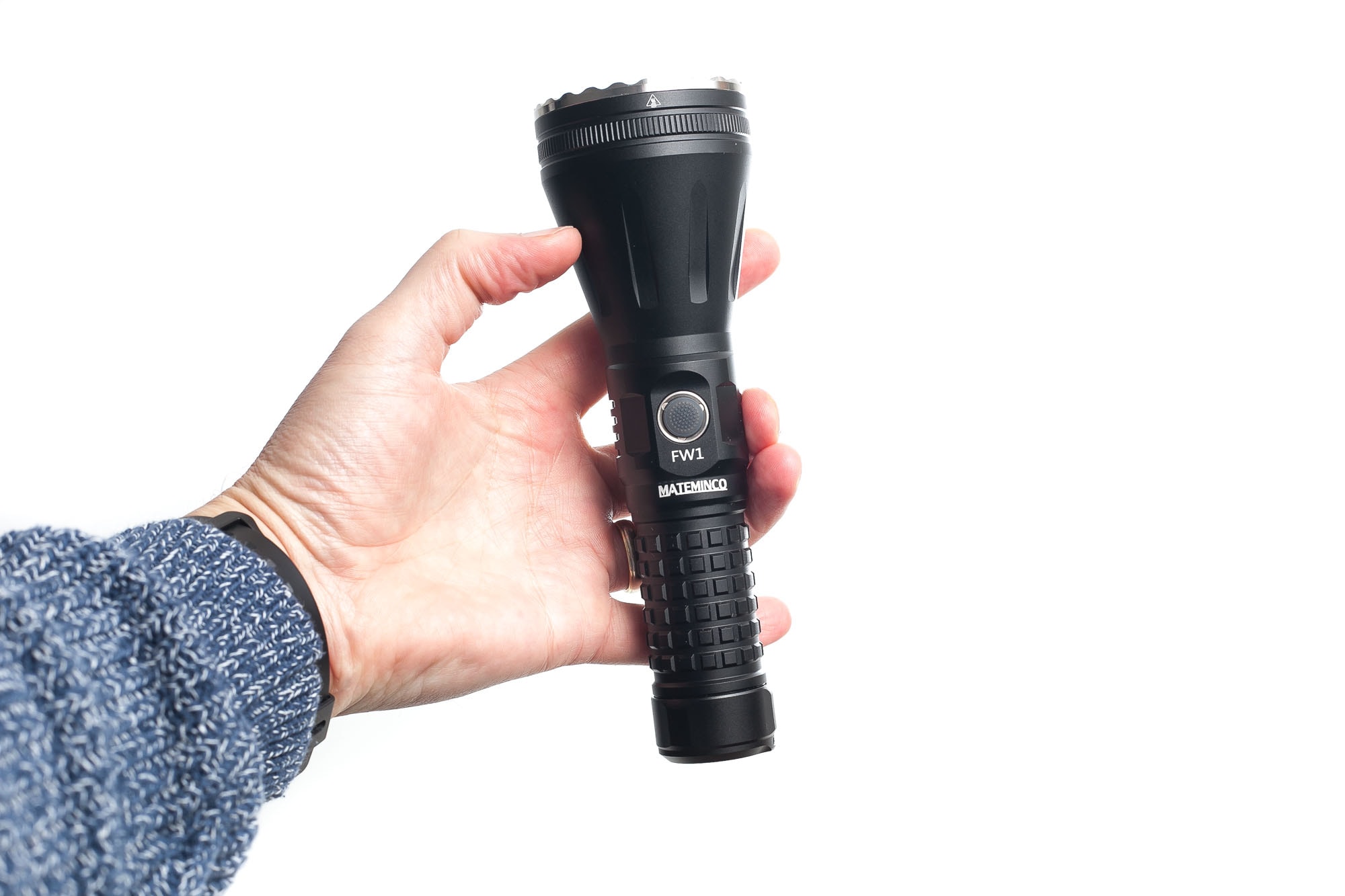
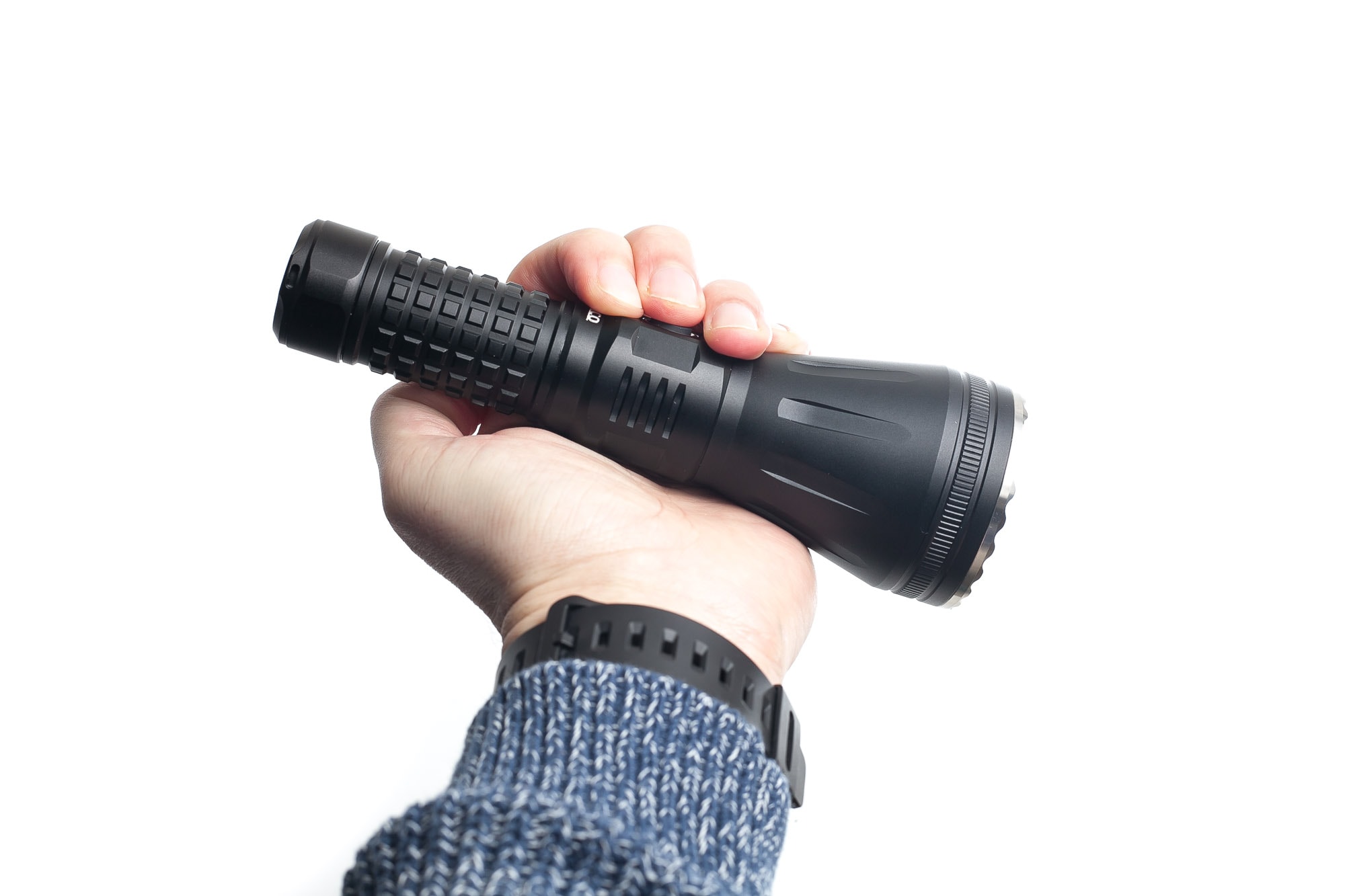
LEP, Lens, Bezel, Beam, and Reflector
Currently, two major types of LEP modules are available: one with a mirror and one with the shine-through system. The mirror-type LEP modules have historically had the highest lumen output and intensity of the two. However, recently, there has been a third type of LEP, and that’s SMD LEP.
That doesn’t mean that the shine-through types aren’t performing well because they have improved quite a bit in the past few years, and the new Weltools are a good example. They are especially popular in smaller flashlights because the LEP modules are much smaller.
Besides its good-looking design, there’s also 1 thing that makes the FW1 look even more attractive: namely, a stainless steel bezel.
Stainless steel not only has a better appearance but also has a stronger build and can withstand strong impacts better. If you were unaware of this fact, you could perform a simple test by dropping two flashlights- one with an aluminum bezel and the other with a stainless steel bezel- from a height of 2 meters, ensuring that the bezel hits the floor first. The flashlight with the least damage will be the one with the stainless steel bezel…. I know.. nobody will do that…
The beam itself is not white but more yellowish. If you care a lot about High CRI, BBL, and tints, I would recommend getting your preferred LED instead. The hotspot is very intense, and will have a donut hole (actually a rectangular shape) at very close distance. This is normal, so don’t worry about it.
I did not test the beam with a spectrometer that I’m used to do with LED flashlights, because that’s not what an LEP flashlight is about. They don’t focus on nice beam quality.
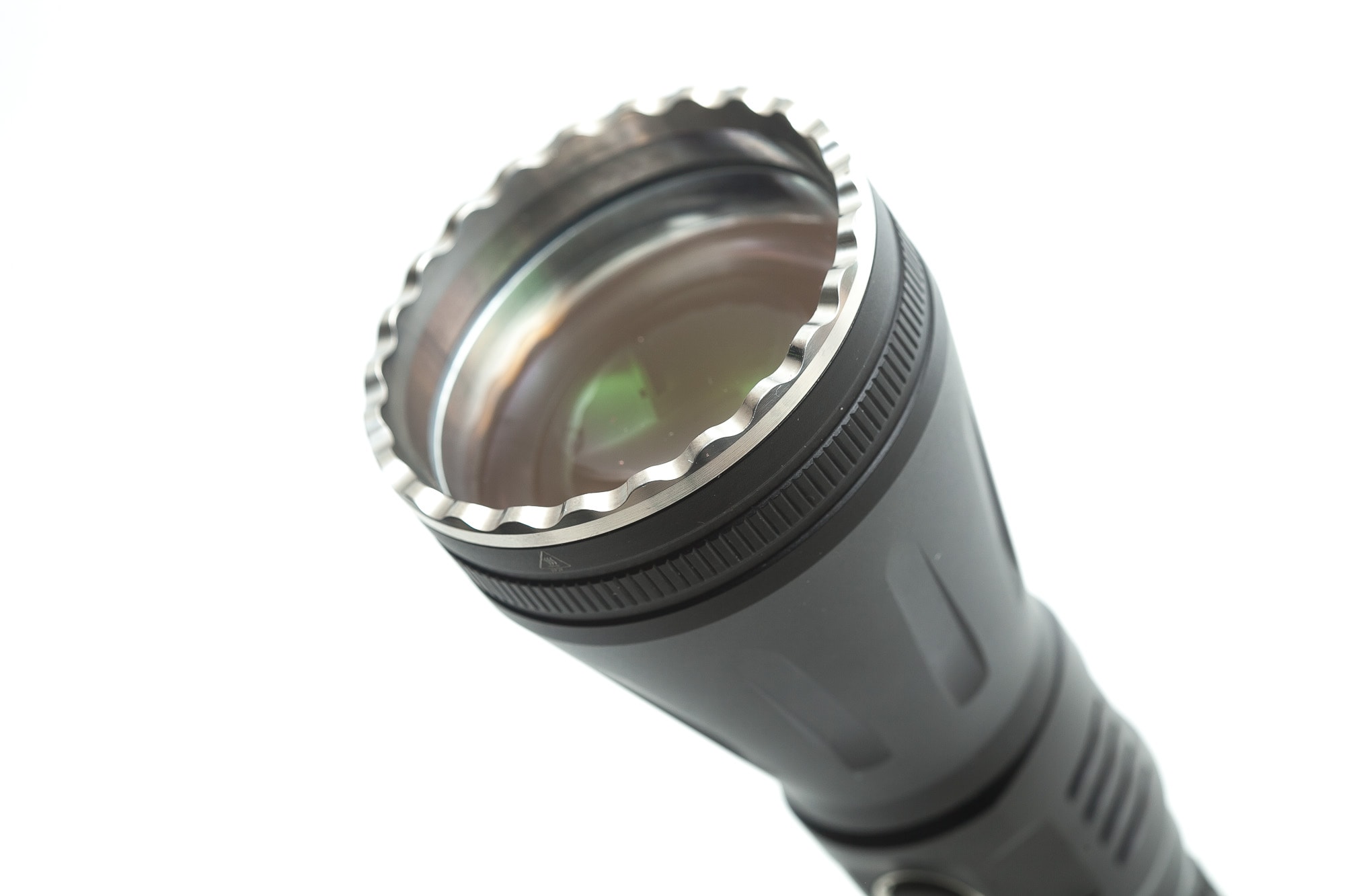
Dimensions and its competition
Dimensions:
| Mateminco FW1 | Millimeters | Inches |
|---|---|---|
| Length | 185 mm | 7.3 in |
| Head diameter | 60 mm | 2.4 in |
| Tailcap diameter | 34mm | 1.3 in |
Dimensions are rounded to the nearest millimeter and the nearest tenth of an Inch.
Weight:
| Mateminco FW1 | Weight in grams | Weight in oz. |
|---|---|---|
| Without battery: | 322 g | 11.35 oz |
| With battery | 391 g | 13.8 oz |
Weight is rounded to the nearest gram and tenth of an Oz.
Mateminco FW1 Flashlight comparison
Size compared to other LEP flashlights
Group 1, from left to right: Weltool W4 Pro, Acebeam W35, Acebeam W30, Mateminco FW1, Astrolux WP3, NlightD L1, Nitecore P35i, Maxtoch L2Kds, Nextorch T20L, Lumintop Thor 3.
Group 2, Mateminco FW1, Astrolux WP3. You can see the old vs new driver there.

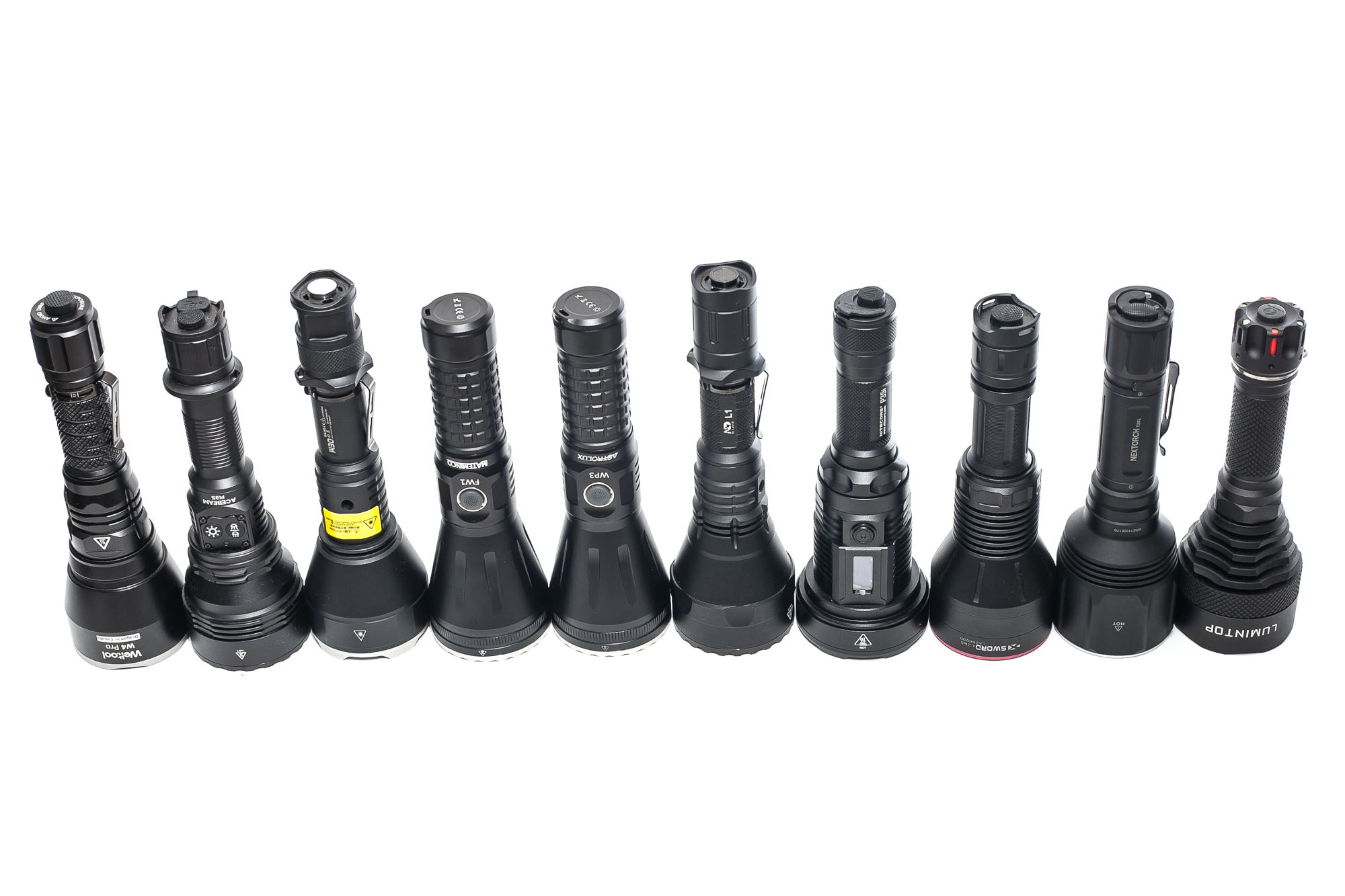


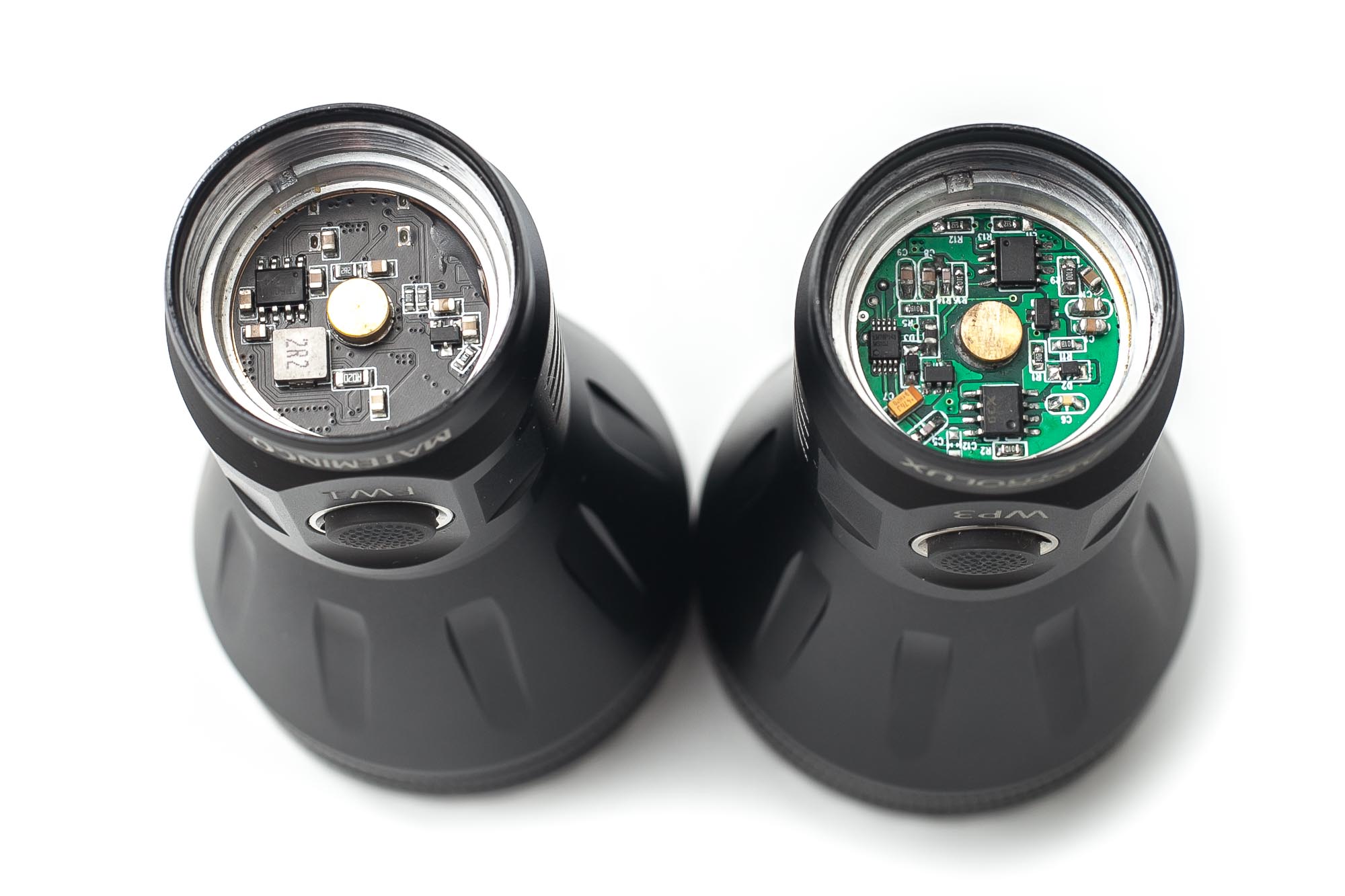
Mateminco FW1 UI : User interface and driver
The available main modes:
- Low, Mide High (I would prefer to call it: Low, High, Turbo)
The available special modes (blinkies):
- Strobe
How the UI works when the flashlight is still turned OFF:
- Single-click: High
- Double click: Turbo
- Triple-click: Strobe
- Press and hold: High
How the UI works when the flashlight is turned ON:
- Single-click: Cycle between Low and High
- Double click: Turbo
- Triple-click: Strobe
- Press and hold 4sec: turn off
Shortcuts within the UI:
- To Turbo: Double click from on/off
- To Low: none
- To Strobe: triple click from on/off
Mode memory:
- None. The WP3 will always start in High, unless you use the shortcut to Turbo or Strobe.
Blinky modes:
- Strobe. Triple click from on/off
Low battery warning:
- Side switch shows red light when battery is low
Lock-out mode:
- N/A
PWM:
- Not visible. My Astrolux WP3 had quite a bit of PWM. But not this one.
Firmware / UI Conclusion:
- The extremely long press for OFF is a little strange.
Mateminco FW1 old vs new driver
A few years ago, I reviewed the Astrolux WP3, which was identical to the FW1. But last year, Mateminco decided to change the driver. Friends on Facebook reached out to ask about this new driver, so I contacted Mateminco, and they confirmed it, and sent this FW1 for review.
So, here are the 2 drivers, side by side. On the left is the new driver, and on the right is the old driver.
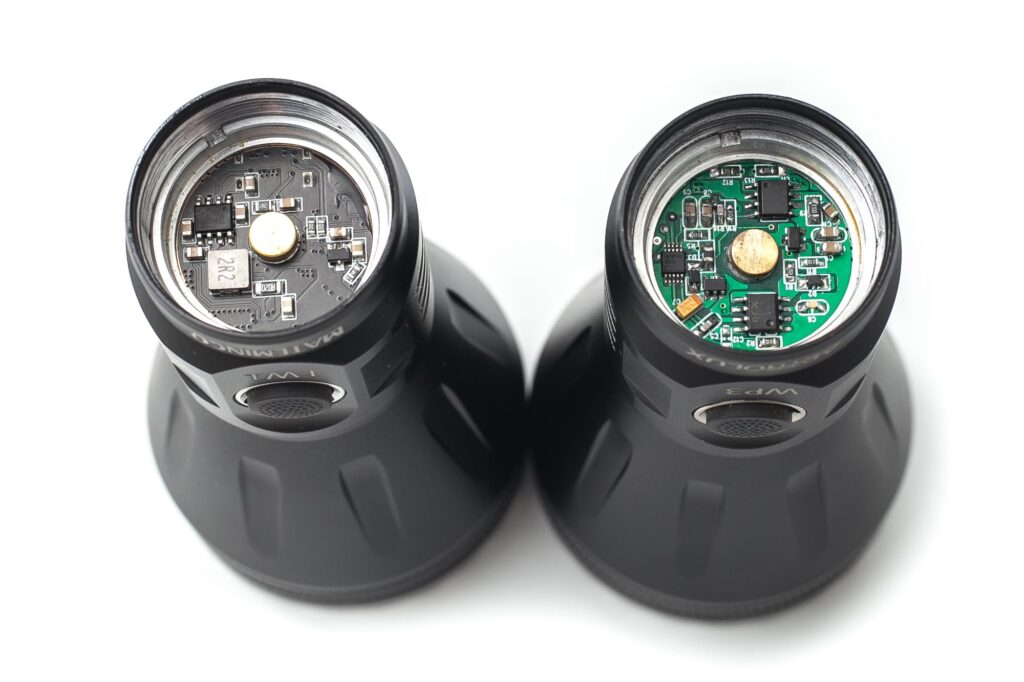
Mateminco FW1 Charging and batteries
The Mateminco FW1 is a 26650 flashlight, but it’s shipped with a 21700 battery tube. And since 26650 batteries are not very popular and kind of an underdog, I focus on a 21700 battery instead. For this review, I mainly used a Samsung INR21700 50G, with a capacity of 5,000mAh. This is a pretty good in-between 21700 battery with a nice balance between capacity and power.
You can charge your batteries inside the FW1 via USB-C. It charges at about 5V, and 2A, so that gives around 10 watts.
Charging a 5,000mAh took 2 hours and 25 minutes till full. The end voltage was 4.16V
| Charge type | Fits | No fit | Charge time |
|---|---|---|---|
| Flashlight with onboard USB-C | 26650 + 21700 sizes | – | 2h 25min (5,000mAh) |


Performance test
This is the gear I use for testing:
| Gear | Purpose | Link to buy |
|---|---|---|
| Hagner E4-X | Measuring beam intensity (throw) | Inquire at Hagner.se |
| 2* Extech SDL400 | Lumens and logging runtimes | Amazon.com, Amazon.co.uk, |
| Leica Disto D2 | Distance for throw measurements | Amazon.com, Amazon.co.uk, |
| Sekonic C-800 | Spectrometer for LED measurements | Amazon.com, Amazon.co.uk |
| Uni-T UTi260B | Thermal Image camera | Amazon.com, |
Lumen measurements:
How Lumens are Measured: Understanding ANSI FL1 Standards How Lumens are Measured: Understanding ANSI FL1 Standards: The ANSI FL1 standards specify that output in lumens should be measured 30 seconds after turning on, as this is the standardized time for measuring brightness according to the industry standard. This is why we focus on this part in our measurements. The ANSI FL1 standards require an ambient temperature of 22 ± 3°C. We record the ambient the ambient temperature to identify potential reasons for any observed discrepancies.The output measurements in this review are based on my homemade integrating spheres, each equipped with an Extech SDL400 Lux Meter. For consistency and accuracy, a calibration light (Convoy S2+ with 249lm and a Convoy S2+ with 261lm) is measured before each set of lumen measurements.
One of the lux meters uses an ND camera filter for high-output lights to prevent the lux meter from maxing out. This is either the Kenko PRO1D ND16 for up to about 80,000 lumens or the Gobe ND32 for anything above.
All of my readings were taken from a fully charged cell. Tested the Samsung 40T, 30T, and 50G. The 50G was used for the runtimes to align with its competition.
The measurements were taken manually at turn on and 30 seconds. The 10-minute numbers are taken from the runtime graph. Runtimes were done with the Samsung 50G.
| Mode | Specs | at turn on | 30 sec | 10 min |
|---|---|---|---|---|
| Low (50G) | 95 lm | 118 lm | 119 lm | 116 lm |
| High (50G) | 412 lm | 532 lm | 518 lm | 498 lm |
| Turbo (50G) | 562 lm | 711 lm | 678 lm | 626 lm |
| Turbo (40T) | 562 lm | 717 lm | 682 lm | – |
| Turbo (30T) | 562 lm | 714 lm | 682 lm | – |
I try to use rounded lumen numbers, except for maybe Low or Moonlight/Firefly modes.
Ambient temperature during testing:
- 18.8 degrees Celsius
Parasitic drain:
- Around 17 µA
Mateminco FW1 Battery life and runtime
How Runtimes are Measured: Understanding ANSI FL1 Standards About ANSI FL1 runtime standards: The runtime is measured until the light drops to 10% of its initial output (30 seconds after turning on). This does not mean that the flashlight is not usable anymore. The last column shows how long the light actually works till it shuts off. If there is a + symbol, it means that the test was stopped at that particular point, but the light was actually still running. This happens on certain occasions, with certain drivers, firmware, or batteries.Runtime tests were conducted in my 50cm homemade integrating sphere, paired with the Extech SDL400 data logging Lux Meter. Temperatures from the moment the runtime test started.
| Mode | Specified | Runtime (ANSI FL1) | Time till shut off |
|---|---|---|---|
| Low (17.9 °C) | 4h | 5h 58min | 5h 58min |
| High (18.5 °C) | 1h 40min | 1h 38min | 1h 38min |
| Turbo* ( 18.7°C) | 60 min | 18 min | 18 min |
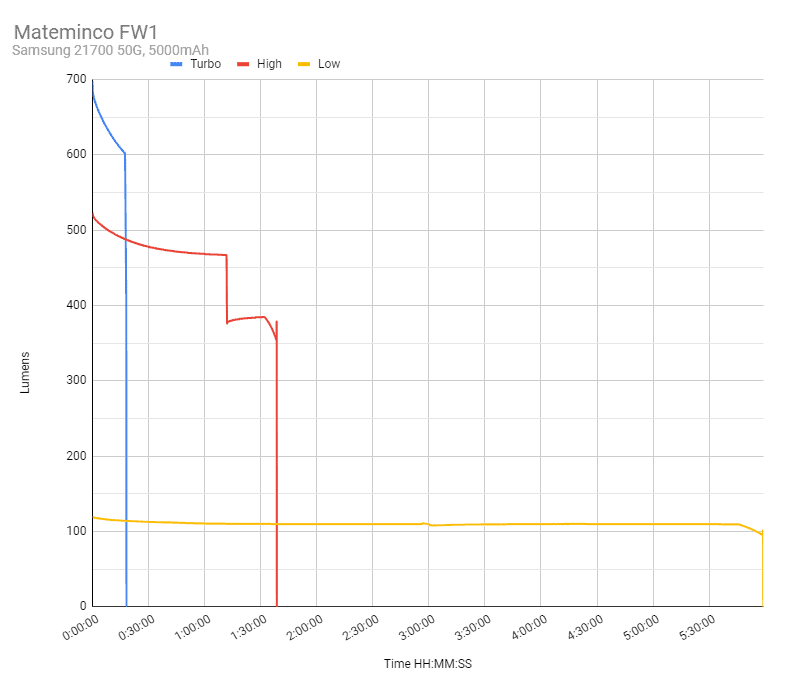
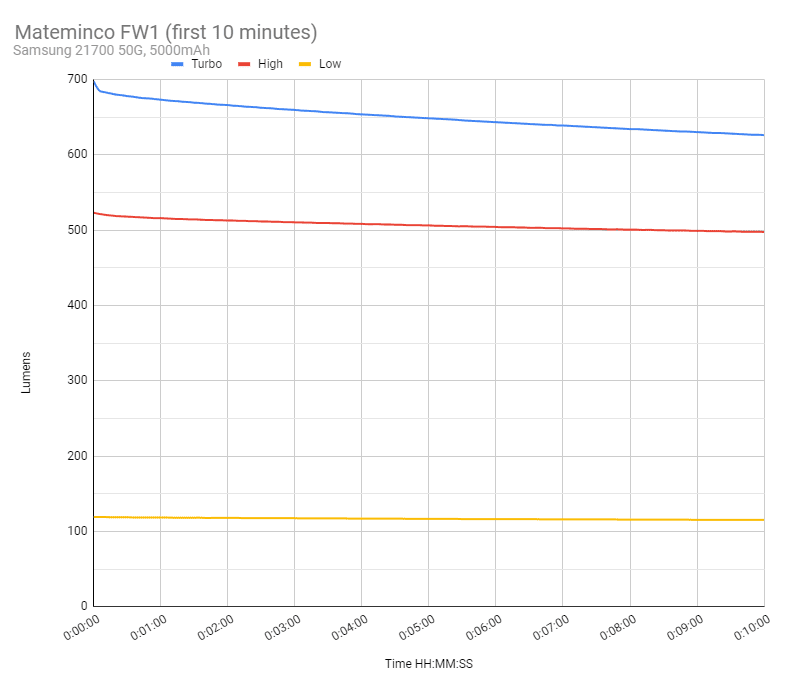
18 minutes of Turbo mode is very, very short. I didn’t realize it at first. My initial thought was: wow, this bugger pulls a lot of current. But then a quick math didn’t make sense.. If a 5,000mAh battery can be emptied in 15 minutes… it must be pulling 20Amps… and I didn’t think that was right, especially not because the Samsung 50G is not a high-discharge battery.
So, I decided to test it with a Samsung 30T, a high-discharge battery. But this time, the runtime was similarly short. I then noticed that the end voltage was 3.75 Volts… which is unbelievably high. I then tested again with a 50G… and the same thing happened. The flashlight turned off before 20 minutes, and the end voltage was 3.94 volts. There must be an issue here.
So, I decided to use a fan to keep the flashlight cooled. And yes, that kept the flashlight running till it turned off and the battery measured 3.14V.. much better… and the results were pretty impressive
Here are the results:
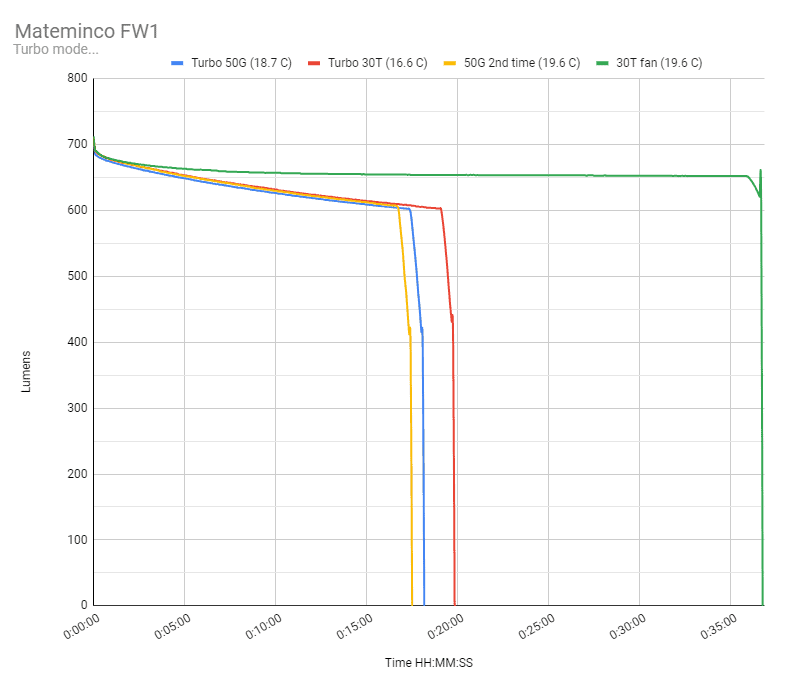
But, this means that the Mateminco FW1 has some thermal issues. It’s either with heat dissipation from the LEP Module, driver, or both. Either or, the flashlight is not working as it should! And that’s a real shame because this performance was out of this world. But it’s pushing it a little too far.
Other users had noticed the same behavior.
Side note: if you use it for, let’s say, 5 minutes at a time, you are still good to go. But it’s unclear how much the ambient temperature helps keep the flashlight running. You might be lucky with lots of wind and a cool temperature outdoors to keep the flashlight running till the battery is empty, but there are no guarantees. And because of the thermal issues, I can’t recommend this flashlight for any professional job. You can’t rely on a flashlight that abruptly turns off and possibly damages something along the way.
Mateminco FW1 vs Astrolux WP3
Here is a comparison between the 2. The Mateminco has a much higher output, but the runtime is extremely short. You easily notice the runtime to end prematurely. This is the runtime without fan.
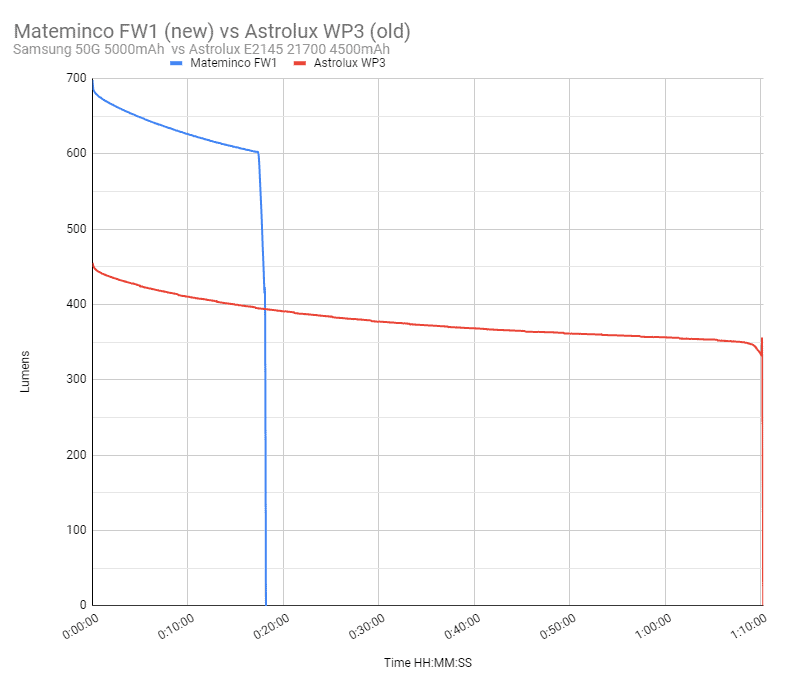
Mateminco FW1 Peak beam intensity and beam distance measurements
About Peak beam intensity: Understanding ANSI FL1 Standards About peak beam intensity The calculated value of distance in meters at which the flashlight produces a light intensity of 0.25 lux. (0.25 lux is about the brightness of a full moon shining on an object). This means that the intensity has decreased so much, it becomes difficult to see darker objects, or objects that don’t reflect light. The columns ‘Meters’ and ‘Yards’ use rounded numbers.I tested it three times. The first time was at 0 degrees outside, and I bumped into my neighbor, so I wasn’t sure if I did it correctly. The numbers were higher than the Weltool W4 Pro I tested. I left the flashlight outside, charged the batteries (50G and 30T), and returned to test again. This time the measurement was lower.. And I thought.. ok, this must be the correct reading, because I could have messed up my earlier measurement. Then it struck me that I left the flashlight outside while charging the batteries.
So, I couldn’t accept the difference, so I decided to wait for a clear night and test again. This time I double checked the distance, and took my time to set everything up.It was about 8-9 degrees Celsius, and the numbers were even better.
You must remember that these measurements are done with a high-end lux meter, but the ambient temperature and dirt in the air do influence the readings. This could be like 40,000 cd difference or 1-2%. So if you compare 2 of my LEP flashlight measurements, and if they are very close, you should focus on other performance factors and features. You won’t be able to notice a difference of 100,000 candelas at this point. (I am talking about flashlights reaching 3,000 meters or more).
Measurements were taken outdoors at 20 meters with a Hagner E4-X Lux Meter. The measurements were taken 30 seconds after turn on.
| Mode | Specified | Measured | meters | yards | miles |
|---|---|---|---|---|---|
| Low | 520,000 cd | 1442 m | 1577 yd | 0.90 mi | |
| High | 2,160,000 cd | 2939 m | 3215 yd | 1.83 mi | |
| Turbo (50G 0 degrees) | 2,180,000 cd | 2,816,000 cd | 3356 m | 3670 yd | 2.09 mi |
| Turbo (30T 0 degrees) | 2,820,000 cd | 3359 m | 3673 yd | 2.09 mi | |
| Turbo (50G 8 degrees) | 2,832,000 cd | 3366 m | 3681 yd | 2.09 mi | |
| Turbo (30T 8 degrees) | 2,844,000 cd | 3373 m | 3689 yd | 2.10 mi |
Ambient temperature during testing:
- 0-8 degrees Celsius
Here’s some comparison.. But I will not add the FW1 to the list because of the thermal issue.
Candela comparison: best single-cell large head LEP flashlights
A list of the best single-cell LEP flashlights with large heads we reviewed: These numbers are NOT from the specifications but are measured by our reviewers. They include all single-cell LEP flashlights with large heard (+-60mm and above). The numbers include the measurement in lumens (lm), measure candela (cd), and calculated distance in meters, and yards. These numbers are all measured 30 seconds after turning on.
| Flashlight (click for review) | @30sec (lm) | Candela (cd) | Meters | Yards |
|---|---|---|---|---|
| Acebeam W30 | 498 | 1,312,000 | 2291 | 2505 |
| Acebeam W35 | 733 | 1,892,000 | 2751 | 3009 |
| Amutorch BT60 | 316 | 1,644,000 | 2564 | 2804 |
| Astrolux WP2 | 303 | 1,248,000 | 2234 | 2443 |
| Astrolux WP3 | 445 | 2,412,000 | 3106 | 3397 |
| FireFlyLite LEP01 | 391 | 816,000 | 1807 | 1976 |
| Jetbeam M1X WP-RX | 491 | 2,280,000 | 3020 | 3302 |
| Lumintop Thor 3 | 311 | 1,728,000 | 2629 | 2875 |
| Maxtoch L2KS | 442 | 2,308,000 | 3038 | 3323 |
| Nextorch T20L | 975 | 1,284,000 | 2266 | 2478 |
| NlightD L1 | 513 | 1,940,000 | 2786 | 3046 |
| Weltool W4 | 450 | 2,184,000 | 2956 | 3232 |
| Weltool W4 PRO | 550 | 2,808,000 | 3351 | 3665 |
And below is an interactive throw comparison graph (candela), between the best single-cell LEP flashlights with large heads. Hover your mouse over the interactive graph below to see the details of each specific light.
(tip: hold your mobile phone horizontally to see the full graph). Or visit the full interactive graph here.
The next graph shows the same graph, but then focusing on the first 60 minutes of their runtimes. Or view the full 60min interactive graph here.
Beamshots
For the following beamshots with the tower, I used a Canon EOS 5D mk2 with a 100mm lens. Manual settings: ISO1600, 0.5sec, F4, 5000K
The tower is about 450 meters / 492 yards away.
Explore and compare the beamshots from the following flashlights:
- Mateminco FW3
- Astrolux WP3
- Acebeam W35
- NlightD L1
- Lumintop Thor 3
- NEXTORCH T20L
- Weltool W4
- Weltool W4 Pro
Please note that the following beamshots are mainly intended to showcase the beam pattern and beam quality, rather than overall performance. These images are typically taken directly after activation, and in different seasons or weather conditions, and therefore do not fully represent its overall performance. For accurate performance metrics, such as output, beam distance, and runtimes, you need to look at the performance section of this review.
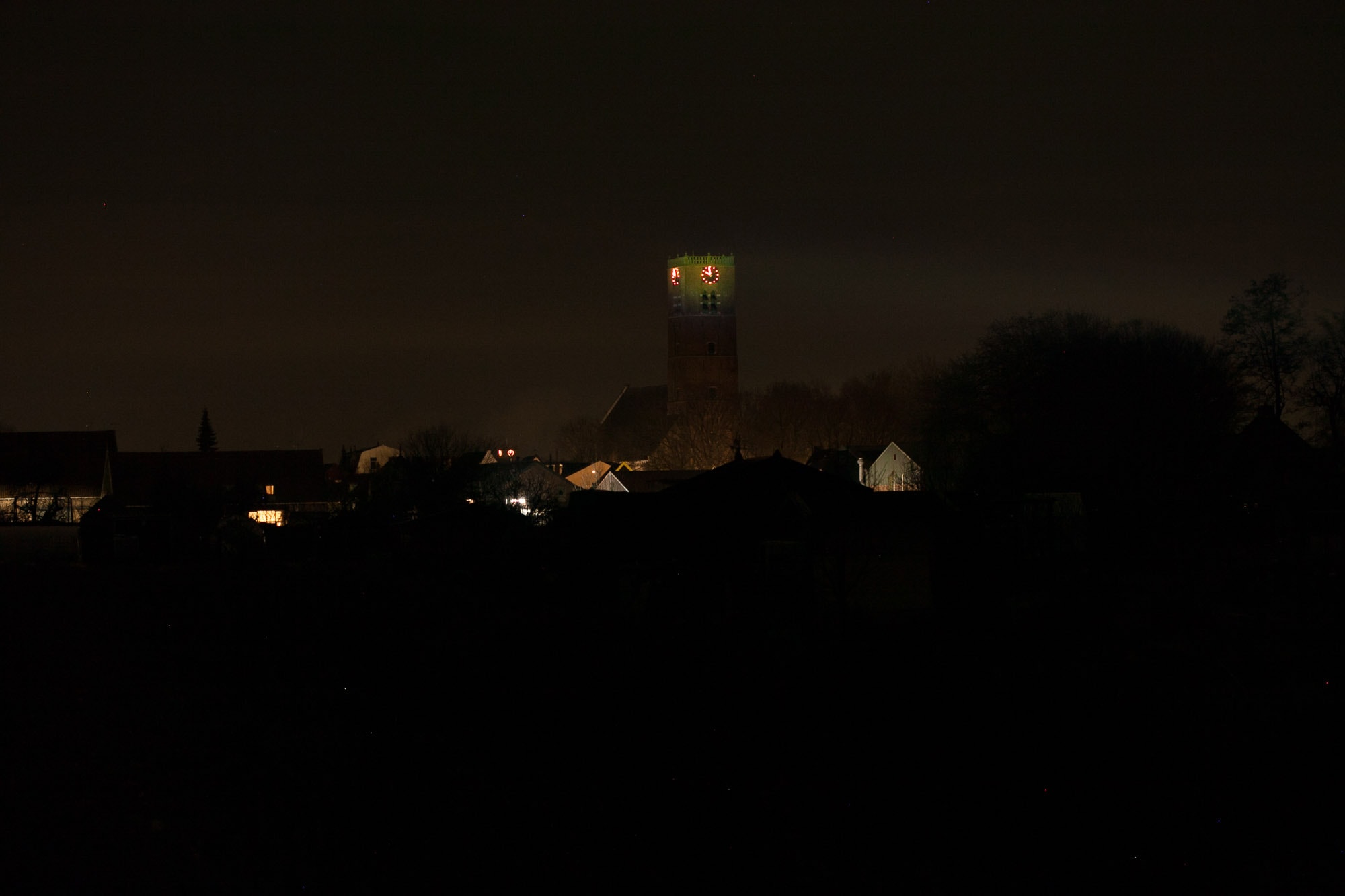
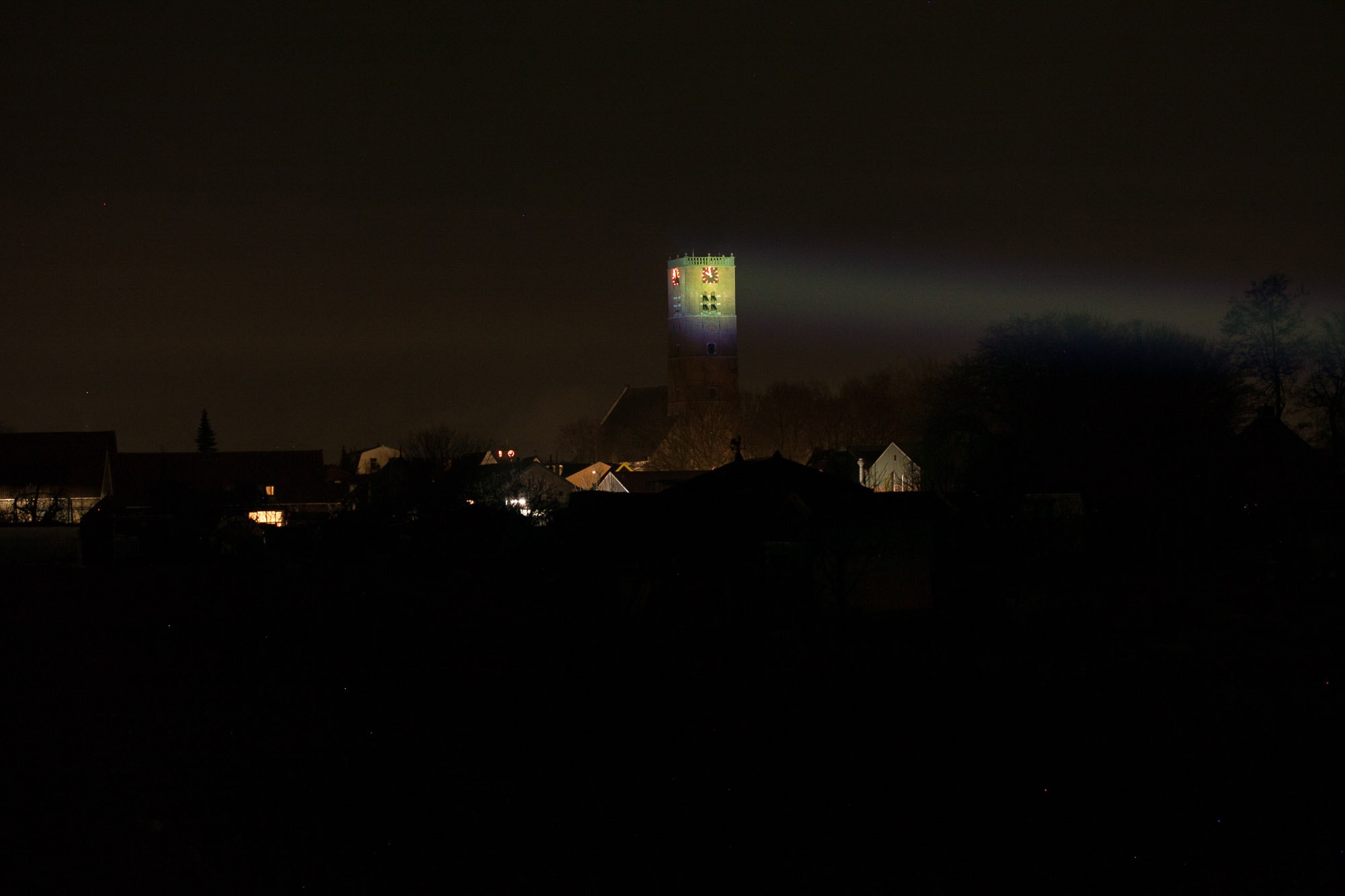

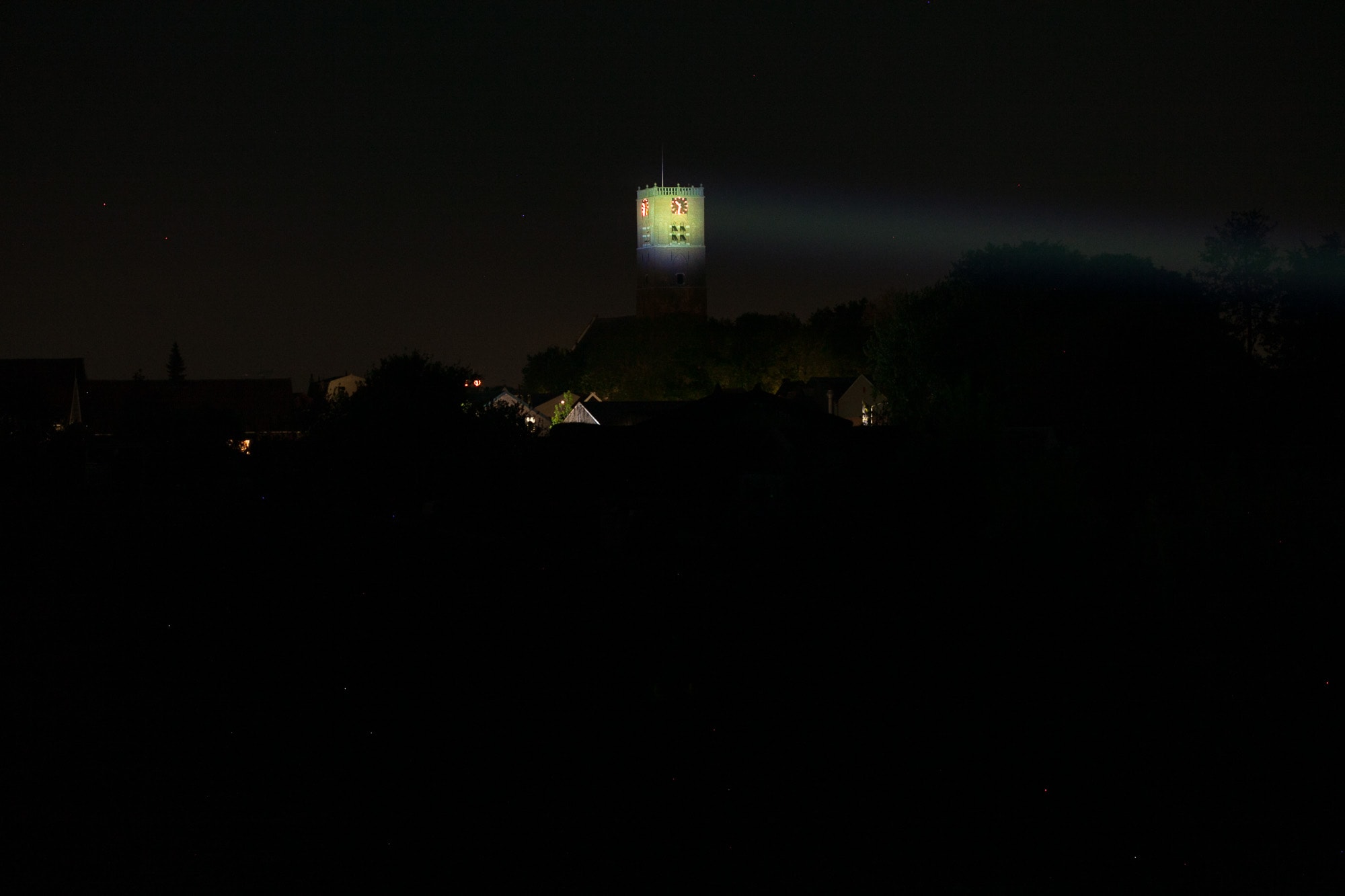
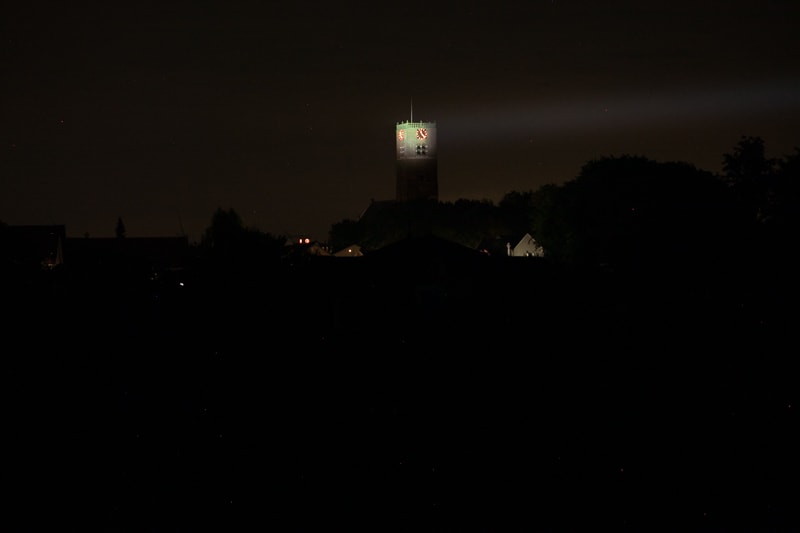
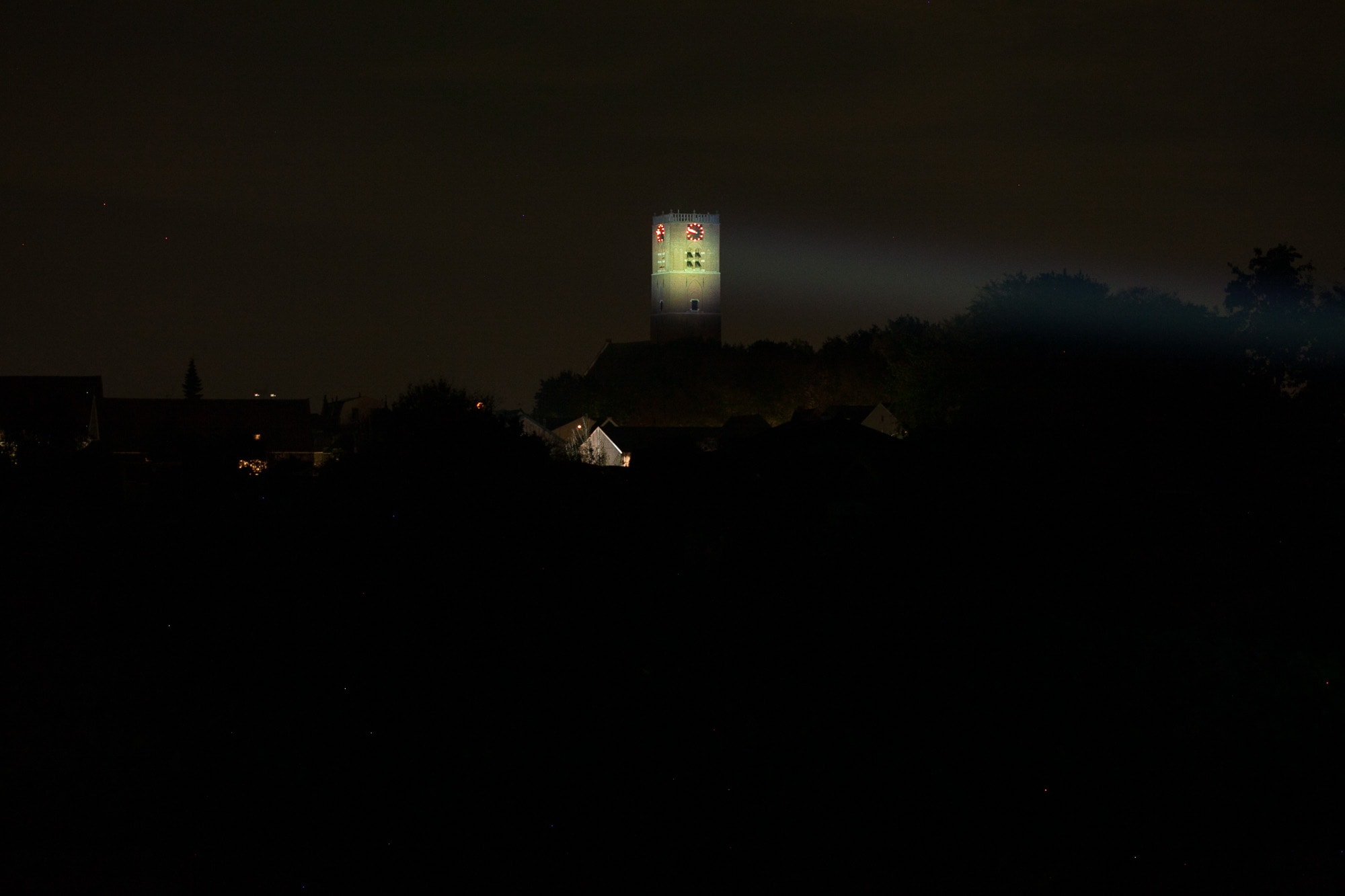
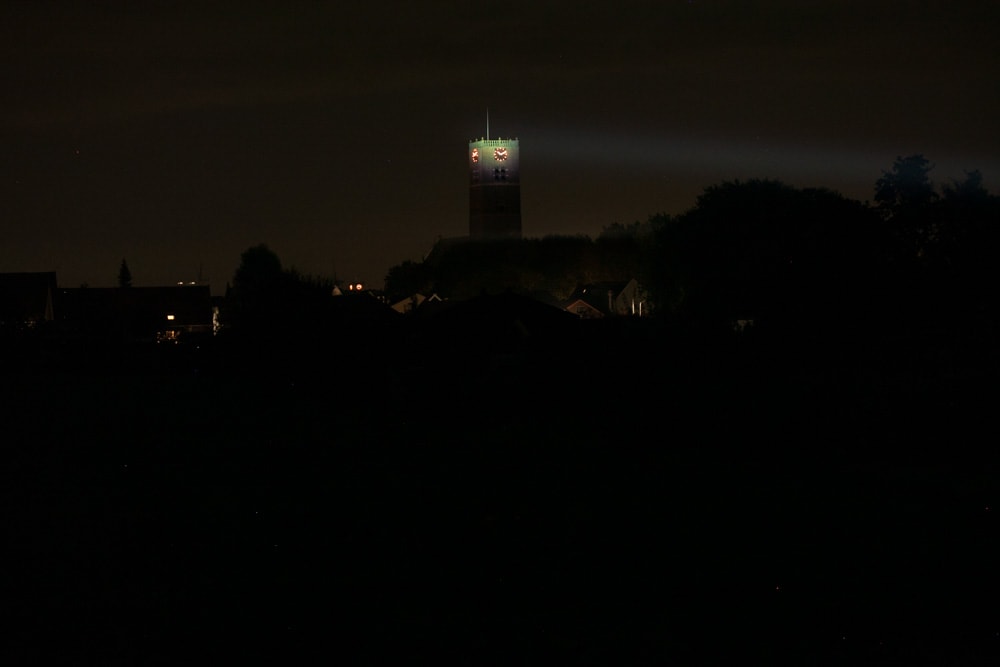
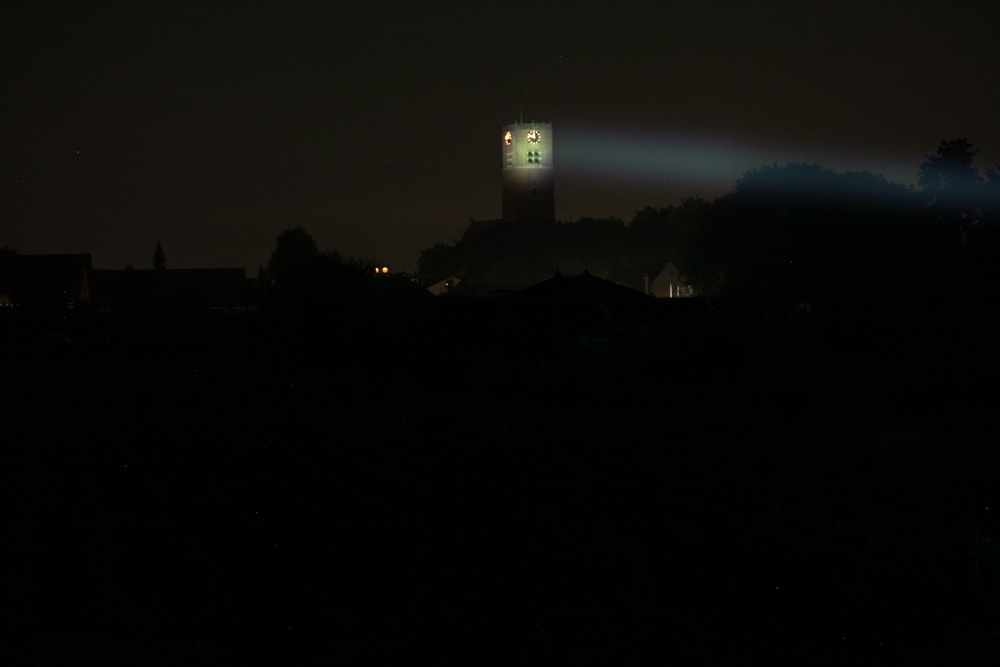
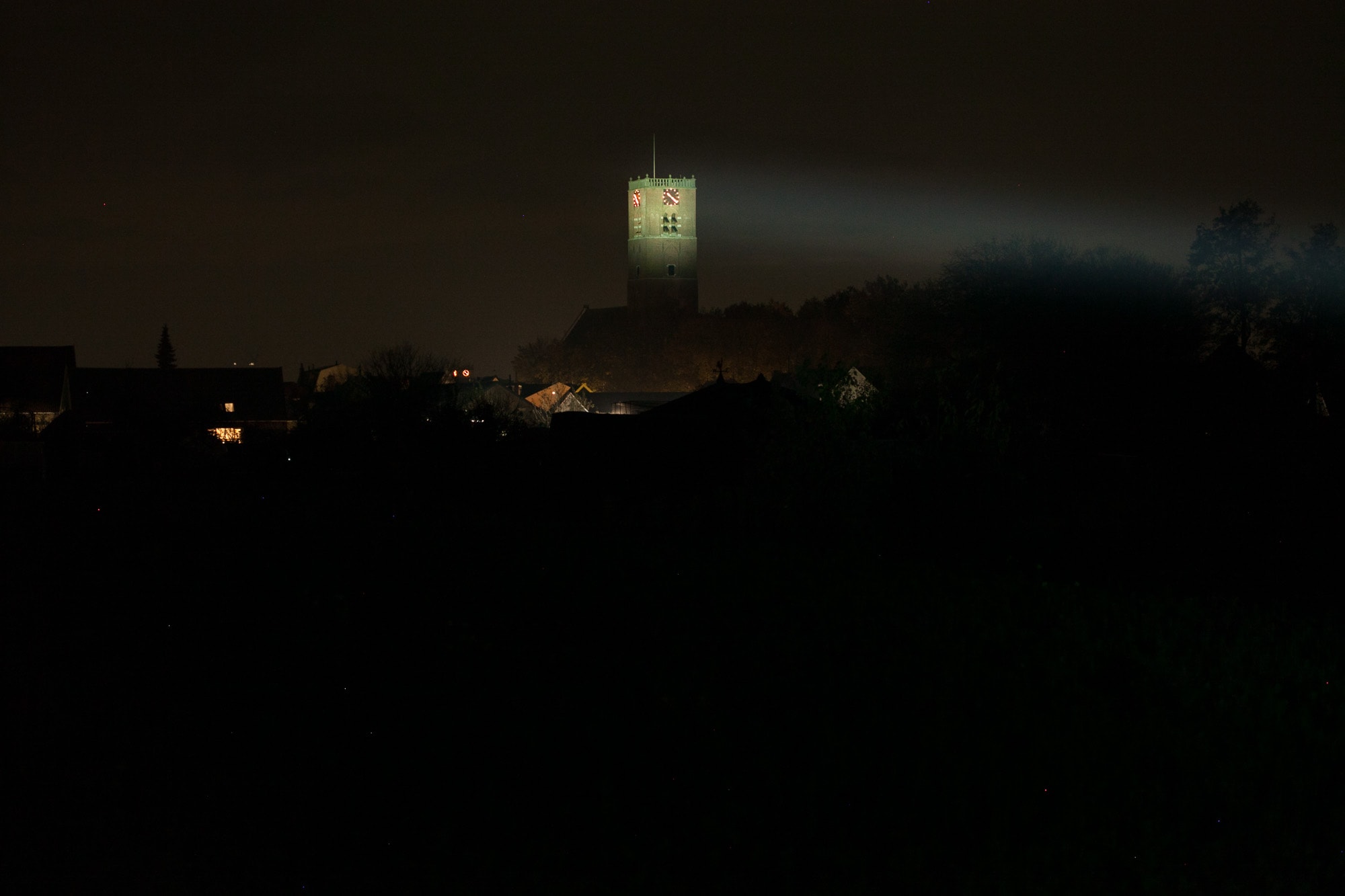
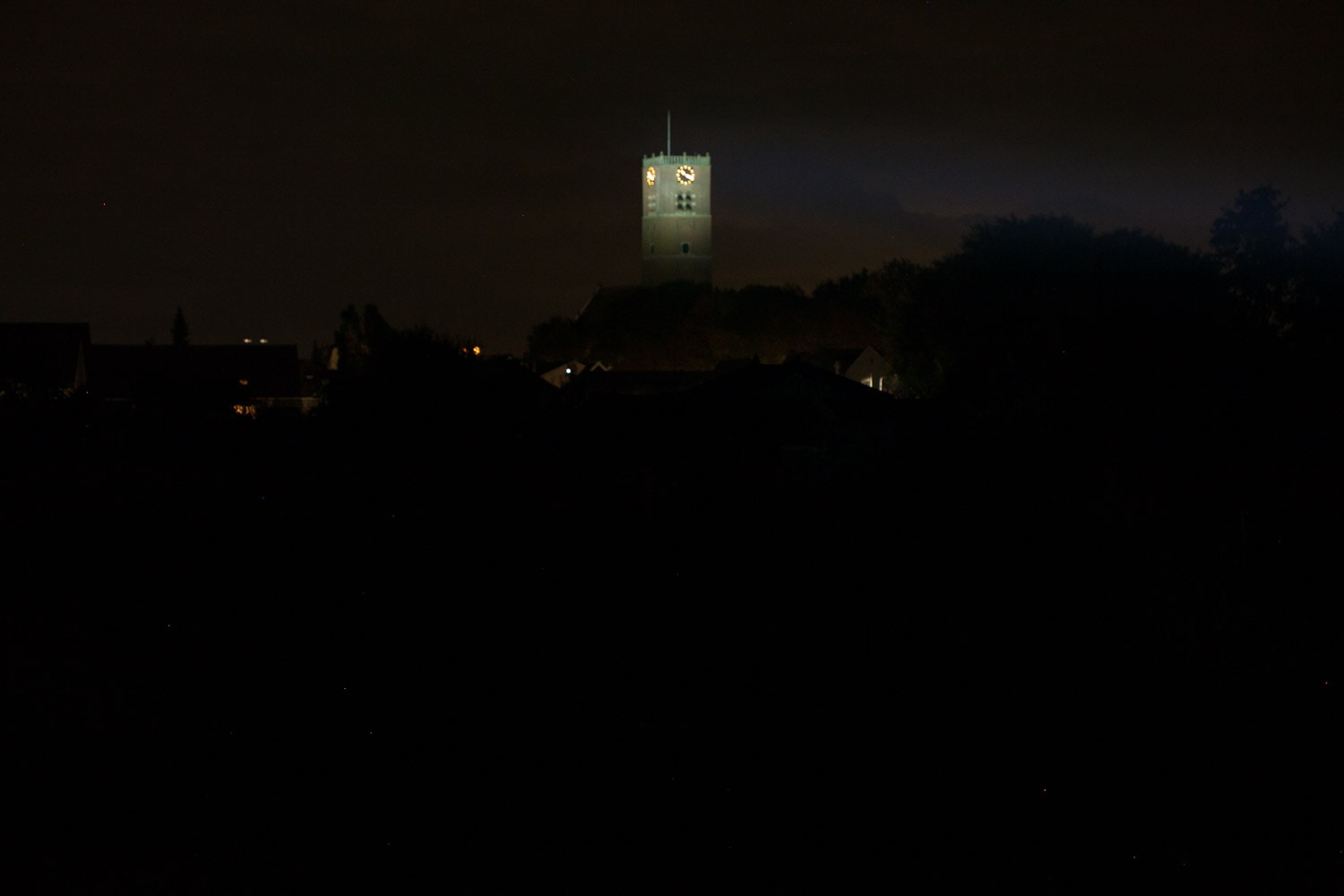
Disclaimer: This flashlight was sent to us for review at no cost by Mateminco. We have not been paid to review, nor have we been holding back on problems or defects.
Final Verdict
Pros
- New, upgraded driver
- Throws really, really far
- Great value/performance*
- Comes with 21700 battery adapter
- Simple UI with low, high, and turbo
Cons
- Very long press to turn off
- *thermal issues, resulting in Turbo turning off prematurely
Explanation on star ratings:
1: Avoid: my phone flashlight would be a better choice – 2: Poor: significant defect or issues; almost unusable – 3: Average: some defects or issues; but still usable 4: Good: recommended (minor issues) – 5: Great: highly recommended

2.5 stars: ★★⋆
While our star rating provides a reliable indicator, we encourage you to read the full review to make an informed decision based on your own needs and preferences.
If I’d merely focus on performance, especially with the fan turned on, this flashlight is impressive and could receive five stars. It throws the farthest of all single-cell LEP flashlights we’ve tested. And if you look at the price/performance ratio, it’s presumably one of the best buys of the moment.
But there is a caveat.
Although Turbo mode is very, very impressive, there is an issue with this flashlight. Due to thermal issues, Turbo mode ends prematurely, with a battery not yet halfway drained. I tested Turbo mode with a fan pointing at it, and it worked flawlessly, so there seems to be a thermal issue. Not knowing whether this can cause damage to either the laser module or the driver, I can not recommend this flashlight.
If you will be using it for a few minutes at a time, it’s still usable, but for something to rely on, I do not recommend it.
Buy your Mateminco FW1 here
1lumen selects and reviews products personally. We may earn affiliate commissions through our links, which help support our testing.